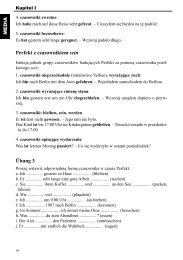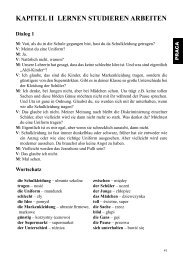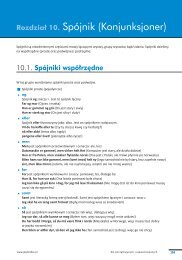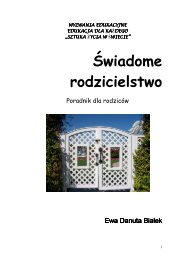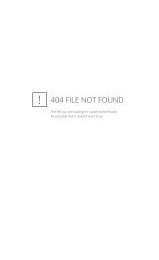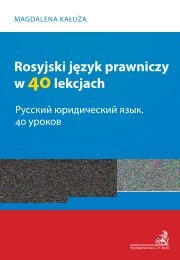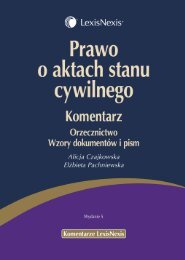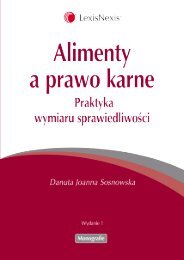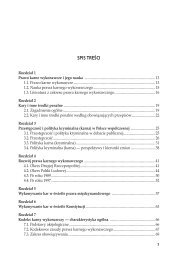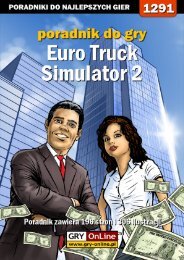zasady wyk£adni prawa podatkowego w krajach ... - Gandalf
zasady wyk£adni prawa podatkowego w krajach ... - Gandalf
zasady wyk£adni prawa podatkowego w krajach ... - Gandalf
Create successful ePaper yourself
Turn your PDF publications into a flip-book with our unique Google optimized e-Paper software.
Polecamy nasze publikacje z zakresu <strong>prawa</strong> <strong>podatkowego</strong>:<br />
Elżbieta Puławska<br />
POLISH TAX LAW<br />
Literatura Obcojęzyczna<br />
Jan Zdanowicz<br />
PODATEK OD CZYNNOŚCI CYWILNOPRAWNYCH,<br />
OPŁATA SKARBOWA<br />
Podatkowe Komentarze Praktyczne<br />
PODATKI 2007<br />
Teksty Ustaw Becka<br />
Roman Kozierkiewicz<br />
DICTIONARY OF ACCOUNTING, AUDIT AND TAX TERMS<br />
Literatura Obcojęzyczna<br />
Wojciech Dmoch<br />
PODATEK DOCHODOWY OD OSÓB PRAWNYCH 2007<br />
Podatkowe Komentarze Praktyczne<br />
KSIĘGOWOŚĆ 2007<br />
Teksty Ustaw Becka<br />
www.sklep.beck.pl
Polecamy nasze publikacje z zakresu <strong>prawa</strong> <strong>podatkowego</strong>:<br />
Elżbieta Puławska<br />
POLISH TAX LAW<br />
Literatura Obcojęzyczna<br />
Jan Zdanowicz<br />
PODATEK OD CZYNNOŚCI CYWILNOPRAWNYCH,<br />
OPŁATA SKARBOWA<br />
Podatkowe Komentarze Praktyczne<br />
PODATKI 2007<br />
Teksty Ustaw Becka<br />
Roman Kozierkiewicz<br />
DICTIONARY OF ACCOUNTING, AUDIT AND TAX TERMS<br />
Literatura Obcojęzyczna<br />
Wojciech Dmoch<br />
PODATEK DOCHODOWY OD OSÓB PRAWNYCH 2007<br />
Podatkowe Komentarze Praktyczne<br />
KSIĘGOWOŚĆ 2007<br />
Teksty Ustaw Becka<br />
www.sklep.beck.pl
Redakcja:<br />
Adrianna Kocewiak-Górska,<br />
Dorota Koprowska<br />
Recenzja:<br />
prof. zw. dr hab. Jan Głuchowski<br />
Wydawnictwo C.H. Beck 2007<br />
Wydawnictwo C.H. Beck Sp. z o.o.<br />
ul. Gen. Zajączka 9, 01–518 Warszawa<br />
Skład i łamanie: Dominik Dzwonkowski<br />
Druk i o<strong>prawa</strong>: P.W.P. INTERDUK Warszawa<br />
ISBN 978-83-7483-486-5
Spis treści<br />
Wykaz skrótów ......................................................................................................... IX<br />
Wykaz literatury .................................................................................................... XI<br />
Wykaz orzeczeń ...................................................................................................... XIX<br />
Wstęp ........................................................................................................................... 1<br />
Rozdział 1. Uwagi o konstrukcji i właściwościach<br />
anglosaskich systemów prawnych ........................................................ 5<br />
1.1. Cechy anglosaskiej kultury prawnej i ich wpływ<br />
na procesy wykładni <strong>prawa</strong>..................................................................... 5<br />
1.2. Normatywne wskazówki wykładni <strong>prawa</strong> ........................................ 10<br />
1.3. Literatura dotycząca wykładni <strong>prawa</strong> ................................................. 13<br />
1.4. Ogólna charakterystyka systemu sądownictwa<br />
w państwach anglosaskich ..................................................................... 14<br />
1.5. Inne zagadnienia ........................................................................................ 17<br />
Rozdział 2. Teorie wykładni <strong>prawa</strong>.<br />
Osiągnięcia amerykańskiej doktryny prawniczej ....................... 19<br />
2.1. Uwagi ogólne ............................................................................................... 19<br />
2.2. Oryginalizm .................................................................................................. 24<br />
2.2.1. In tencjonalizm .................................................................................. 24<br />
2.2.2. Teoria wykładni celowościowej ................................................. 37<br />
2.3. Nowy tekstualizm ....................................................................................... 40<br />
2.4. Teoria wykładni dynamicznej ................................................................. 48<br />
2.5. Podsumowanie ............................................................................................ 52<br />
Rozdział 3. Zasady sądowej wykładni <strong>prawa</strong> w państwach<br />
anglosaskich ....................................................................................................... 55<br />
3.1. Uwagi ogólne ............................................................................................... 55<br />
3.2. Wykładnia językowa ................................................................................... 56<br />
3.3. Niejasności tekstu prawnego.................................................................. 57<br />
3.4. Wykorzystywanie materiałów z procesu legislacyjnego ............... 60<br />
3.5. Luki w prawie .............................................................................................. 63<br />
3.6. Domniemania i wskazówki interpretacyjne...................................... 64<br />
3.6.1. Dyrektywa pomijania rezultatów absurdalnych<br />
(golden rule) ..................................................................................... 65<br />
3.6.2. Dyrektywa pomijania rezultatów<br />
niesprawiedliwych ......................................................................... 67<br />
V
3.6.3. Dyrektywa dążenia do realizacji celu ustawy ........................ 67<br />
3.6.4. Dyrektywa zapewnienia funkcjonalności <strong>prawa</strong> ................. 68<br />
3.6.5. Dyrektywa uwzględniania celu zmiany <strong>prawa</strong><br />
(mischief rule) ................................................................................. 69<br />
3.6.6. Dyrektywa respektowania znaczeń języka<br />
powszechnego (plain meaning rule) ...................................... 69<br />
3.6.7. Zasada respektowania interpretacji zastosowanej<br />
przez agencje rządowe (deferrence rule)................................ 71<br />
3.6.8. Doktryna następczej aprobaty praktyki orzeczniczej<br />
(reenactment doctrine) ................................................................ 72<br />
3.6.9. Maksymy interpretacyjne ............................................................. 72<br />
3.7. Inne <strong>zasady</strong>. .................................................................................................. 74<br />
3.8 Ocena celów oraz intencji podatnika .................................................. 75<br />
Rozdział 4. Problematyka wykładni <strong>prawa</strong> <strong>podatkowego</strong><br />
w amerykańskiej literaturze prawniczej ........................................... 79<br />
4.1. Zagadnienia ogólne .................................................................................... 79<br />
4.2. Oryginalizm w wykładni <strong>prawa</strong> <strong>podatkowego</strong> ................................. 83<br />
4.3. Tekstualizm i antytekstualizm w wykładni <strong>prawa</strong><br />
<strong>podatkowego</strong> ................................................................................................ 84<br />
4.4. Znaczenie „struktury głębokiej” Kodeksu <strong>podatkowego</strong> .............. 89<br />
4.5. Practical reason w wykładni <strong>prawa</strong> <strong>podatkowego</strong> ......................... 92<br />
Rozdział 5. Sądowa wykładnia <strong>prawa</strong> <strong>podatkowego</strong> ........................... 97<br />
5.1. Uwagi ogólne ............................................................................................... 97<br />
5.2. Zasada wykładni ścisłej (strict construction) .................................... 99<br />
5.3. Wykładnia celowościowa przepisów <strong>prawa</strong><br />
<strong>podatkowego</strong> ................................................................................................ 106<br />
5.4. Zasada (strategia) interpretacji zrównoważonej <strong>prawa</strong><br />
<strong>podatkowego</strong> ................................................................................................ 115<br />
5.5. Zasada rozstrzygania wątpliwości na korzyść podatnika .............. 119<br />
5.6. Interpretacja przepisów dotyczących ulg podatkowych,<br />
zwolnień itp. ............................................................................................... 123<br />
5.7. Dyrektywa efektywności <strong>prawa</strong> <strong>podatkowego</strong> ................................ 126<br />
5.8. Inne <strong>zasady</strong> interpretacji stosowane w prawie<br />
podatkowym ................................................................................................. 127<br />
5.8.1. Zasada pierwszeństwa prostszego rozumowania ................ 127<br />
5.8.2. Zasada wykładni z zachowaniem symetrii<br />
w opdatkowaniu ............................................................................. 127<br />
5.8.3. Zasada domniemania zgodności aktów prawnych<br />
administracji z ustawą podatkową ............................................ 128<br />
5.9. Inne zagadnienia .......................................................................................... 128<br />
VI<br />
Spis treści
Spis treści<br />
Rozdział 6. Wykładnia <strong>prawa</strong> a zwalczanie unikania<br />
opodatkowania ................................................................................................. 131<br />
6.1. Istota i rodzaje sądowych doktryn orzeczniczych ........................... 131<br />
6.2. Sądowe doktryny orzecznicze w wybranych państwach ............. 138<br />
6.2.1. Zjednoczone Królestwo ................................................................ 138<br />
6.2.2. Stany Zjednoczone .......................................................................... 144<br />
6.2.3. Kanada ................................................................................................ 148<br />
6.2.4. Australia i Nowa Zelandia ............................................................ 150<br />
6.3. Uwagi końcowe ........................................................................................... 152<br />
Rozdział 7. Sądowe strategie interpretacji <strong>prawa</strong><br />
<strong>podatkowego</strong> ...................................................................................................... 155<br />
Zakończenie .............................................................................................................. 161<br />
Indeks rzeczowy ..................................................................................................... 171<br />
VII
1. Publikacje<br />
Wykaz skrótów<br />
Abb. ........................................ Abbot, U.S. Circuit Court and District Court<br />
Reports<br />
A.C. ........................................ Law Reports: Appeal Cases<br />
Allen ....................................... Allen’s Reports<br />
All E.R. . .................................. All England Law Reports<br />
A.L.R. ...................................... American Law Reports<br />
A.T.C. ..................................... Annotated Tax Cases<br />
A.T.D. ..................................... Australian Tax Decisions<br />
A.T.R. ..................................... Australian Tax Reports<br />
AT Rev. .................................. Australian Tax Review<br />
Bing ........................................ Bingham’s Common Pleas Reports<br />
Cal. ......................................... California Reports<br />
C.A. ........................................ Court of Appeal<br />
Ch. .......................................... Law Reports: Chancery Division<br />
C.L. ......................................... Current Law<br />
C.L.R. ..................................... Commonwealth Law Reports<br />
Conn ....................................... Connecticut R eports<br />
Co Rep ................................... Cokes King’s Bench Reports<br />
C.P. ......................................... Law Reports: Common Pleas<br />
C.T.C. ..................................... Canada Tax Cases<br />
D.L.R. ..................................... Dominion Law Reports<br />
East .......................................... East’s Term Reports, King’s Bench<br />
E.R. ......................................... English Reports<br />
Ex C.R. .................................. Canada Exchecquer Court Reports<br />
F. 2d ........................................ Federal Reporter, Second Series<br />
F. 3d ........................................ Federal Reporter, Third Series<br />
F.C. ......................................... Federal Court<br />
F.C.R. ..................................... Federal Court Reporter<br />
F.C.T.D. ................................. Federal Court Tax Departament<br />
F.L.R. ...................................... Federal Law Reports<br />
H.C. ........................................ Reports of High Court of Griquenland<br />
H.L. ......................................... House of Lords<br />
Ill. ........................................... Illinois Reports<br />
I.L.R.M. .................................. Irish Law Reports Monthly<br />
I.R. .......................................... Irish Reports<br />
K.B. ......................................... Law Reports: King’s Bench Division<br />
IX
KPrP ....................................... Kwartalnik Prawa Prywatnego<br />
L.R.C.P. .................................. Law Reports: Common Pleas<br />
L.R.H.L. ................................. Law Reports: English and Irish Appeals<br />
L.R.Ir. ..................................... Law Reports: Ireland<br />
N.H. ........................................ New Hampshire Records<br />
N.Z.L.J. .................................. New Zealand Law Journal<br />
N.Z.L.R. ................................. New Zealand Law Reports<br />
Pa. ST. .................................... Pennsylvania State Reports<br />
P.C. ......................................... Privy Council<br />
Penn. ..................................... Pennewils Reports<br />
PiP ........................................... Państwo i Prawo<br />
S.C.C. ..................................... Supreme Court of Canada<br />
S.C.C.J. ................................... Session Cases Court of Judiciary<br />
S.C.R. ...................................... Canada Supreme Court Reports<br />
S.Ct. ........................................ Supreme Court Reporter<br />
S.T.C. ...................................... Simon’s Tax Cases<br />
Sup.Ct.Rev. .......................... Supreme Court Review<br />
Taunt. .................................... Taunton’s Commons Pleas Reports<br />
T.C. ......................................... Reports of Tax Cases<br />
U.S. ......................................... United States: Supreme Court Reports<br />
Wall ......................................... Wallace’s United States Supreme Court Reports<br />
W.L.R. ..................................... Weekly Law Reports<br />
2. Inne skróty<br />
art. .......................................... artykuł<br />
aut. ......................................... autor<br />
itd. .......................................... i tak dalej<br />
itp. .......................................... i temu podobne; i tym podobne<br />
nast. ....................................... następny<br />
nr ............................................. numer<br />
poz. ........................................ pozycja<br />
przyp. .................................... przypomnienie<br />
r. .............................................. rok<br />
s. .............................................. strona<br />
tj. ............................................. to jest<br />
tzw. ......................................... tak zwany<br />
v. .............................................. versus<br />
w. ............................................ wiek<br />
wyd. ....................................... wydanie<br />
zob. ........................................ zobacz<br />
X<br />
Wykaz skrótów
Wykaz literatury<br />
Alexander L., Prakash S., Mother May I? Imposing Mandatory Prospective<br />
Rules of Statutory Interpretation, 20 Constitutional Commentary<br />
(2003–2004)<br />
Anstey S., Restricting Ramsay, Taxation 2001, No. 13<br />
Arnold B., Statutory Interpretation: Some Thoughts on Plain Meaning, Report<br />
of Proceedings Fiftieth Tax Conference, Canadian Tax Foundation, Toronto<br />
1998<br />
Atiyah P., Summers R., Form and Substance in Anglo-American Law, Clarendon<br />
1987<br />
Ballard M., Davidson P., United Kingdom: National Report, [w:] Form and<br />
Substance in Tax Law, Studies on International Fiscal Law, Vol. LXXXVIIa,<br />
International Fiscal Association Congress Materials, Oslo 2002<br />
Bankowski Z., MacCormick N., Statutory Interpretation in the United<br />
Kingdom [w:] Interpreting Statutes. A Comparative Study, (red.<br />
N. MacCormick, R. Summers), Dartmouth 1991<br />
Barker W., Statutory Interpretation, Comparative Law, and Economic Theory:<br />
Discovering the Grund of Income Taxation, 40 San Diego Law Review<br />
2003<br />
Bell B., Legislative History Without Legislative Intent: The Public Justification<br />
Approach to Statutory Interpretation, 60 Ohio State Law Review 1999<br />
Bennion F., How they all got it wrong – Pepper v. Hart, British Tax Review<br />
1995, No. 3<br />
Bennion F., Statutory Interpretation, Butterworths 1997<br />
Bittker B., Lokken L., Federal Taxation on Income, Estates and Gifts 4-20<br />
(1989)<br />
Blatt W., The History of Statutory Interpretation: A Study on Form and<br />
Substance, 6 Cardozo Law Review 1985<br />
Breyer S., On the Uses of Legislative History in Interpreting Statutes, 65 South<br />
California Law Review 1992<br />
Brown K. B., Applying Circular Reasoning to Linear Transactions: Substance<br />
over Form Theory in U.S. and U.K. Tax Law, 15 Hastings International<br />
Comparative Law Review 1992/2<br />
Brown R., Regulations, Reenactment and the Revenue Acts, 54 Harvard Law<br />
Review (1941)<br />
XI
Brzeziński B., Anglosaskie doktryny orzecznicze dotyczące unikania<br />
opodatkowania, Toruń, 1996<br />
Brzeziński B., Ewolucja strategii interpretacji ustaw podatkowych<br />
w orzecznictwie Sądy Najwyższego Kanady [w:] Pro Publico Bono. Księga<br />
Jubileuszowa Profesora Jana Głuchowskiego, Toruń 2002<br />
Brzeziński B., O idei uproszczenia <strong>prawa</strong> <strong>podatkowego</strong> [w:] Konstytucja.<br />
Ustrój, system finansowy państwa, Księga Pamiątkowa ku czci Profesor<br />
Natalii Gajl, Warszawa 1999<br />
Brzeziński B., O potrzebie sformułowania sądowej strategii interpretacji ustaw<br />
podatkowych [w:] Sądownictwo administracyjne gwarantem wolności<br />
i praw obywatelskich 1980–2005, Warszawa 2005<br />
Brzeziński B., Poglądy Sędziego Antonina Scalii na wykładnię <strong>prawa</strong><br />
i ich odbiór w amerykańskiej doktrynie prawniczej, [w:] Przemiany<br />
doktrynalne i systemowe <strong>prawa</strong> publicznego. Studia dedykowane prof.<br />
Wincentemu Bednarkowi, Olsztyn 2002<br />
Brzeziński B., Współczesne amerykańskie teorie wykładni <strong>prawa</strong>, PiP 2006,<br />
Nr 7<br />
Brzeziński B., Wykładnia <strong>prawa</strong> <strong>podatkowego</strong> i orzekanie w s<strong>prawa</strong>ch<br />
podatkowych w państwach anglosaskich, KPrP 2004, Nr 4<br />
Burns W., Krever B., 1999 Australian Taxation Law, CCH Australia Ltd<br />
Caron P., Tax Myopia, or Mamas Don’t Let Your Babies Grow Up to Be Tax<br />
Lawyers, 13 Virginia Tax Review 1994<br />
Corkey J., On Literalism, Rule of Law and Due Process, Revenue Law Journal,<br />
Vol. 13, 2003<br />
Coverdale J., Text as Limit: A Plea for the Decent Respect for the Tax Code,<br />
71 Tulane Law Review, May 1997<br />
Crespi G., The Influence of a Dedcade of Statutory Interpretation Scholarship on<br />
Iudicial Reasoning: An Empirical Analysis, 53 Southern Metodist University<br />
Law Review, Winter 2000<br />
Cross R., Statutory Interpretation, Butterworths 1995<br />
Dickerson R., Statutory Interpretation: Dipping into Legislative History,<br />
11 Hofstra Law Review 1983<br />
Dickerson R., The Interpretation and Application of Statutes, 1975<br />
Dodge J. M., The Logic of Tax 1989<br />
Doernberg R., Chesney F., On the Accelerating Rate and Decreasing Durability<br />
of Tax Reform, 71 Minnesota Law Review 1987<br />
Duff D. G., Interpreting the Income Tax Act – Part 1: Interpretive Doctrines,<br />
Canadian Tax Journal 1999, Vol. 47, No. 3<br />
Duff D., Interpreting the Income Tax Act – Part 2: Toward a Pragmatic Approach,<br />
Canadian Tax Journal 1999, Vol. 47, No. 4<br />
Dworkin R., Political Judges and the Rule of Law, [w:] Laws Empire, Cambridge<br />
1986<br />
XII<br />
Wykaz literatury
Wykaz literatury<br />
Dyson J., Interpreting Tax Statutes, [w:] Legislation and the Courts (red.<br />
M. Freeman), Dartmouth, Aldershot 1997<br />
Easterbrook F., Statute’s Domain, 50 University of Chicago Law Review, Spring<br />
1983<br />
Eskridge W., Jr., The New Textualism, Uniwersity of California Law Review,<br />
April<br />
Eskridge W., Jr., Dynamic Statutory Interpretatin, 135 University of Pennsylvania<br />
Law Review 1987<br />
Eskridge W., Jr., Frickey P., Statutory Interpretation as Practical Reasoning,<br />
42 Stanford Law Review, January 1990<br />
Eskridge W., Jr., Legislative History Value, 66 Chicago-Kent Law Review 1992<br />
Eskridge W., Jr., Legislative History Values, 66 Cicago-Kent Law Review 1990<br />
Eskridge W., Jr., The New Textualism, 37 University of California Law Review<br />
1990<br />
Eskridge W., Politics Without Romance: Implications of Public Choice Theory<br />
for Statutory Interpretation, 74 Villanova Law Review, 1988<br />
Farber D., Friceky P., Jurisprudence of Public Choice, 65 Texas Law Review<br />
1987<br />
Farber D., Frickey P., Legislative Intent and Public Choice, 74 Vanderbilt Law<br />
Review, 1988<br />
Farber D., Frickey P., Legislative Intent and Public Choice, 74 Villanova Law<br />
Review 1988<br />
Felesky B., Jack S., Is There a Substance to „Substance over Form” in Canada?<br />
Report of Proceedings Fourty-Fourth Tax Conference, Canadian Tax<br />
Foundation, Toronto 1992<br />
Frankfurter J., Some Reflections on the Reading of the Statutes, 47 Columbia<br />
Law Review 1947<br />
Frickey P., From the Big Sleep to the Big Heat: The Reviwal of Theory in<br />
Statutory Interpretation, 77 Minnesota Law Review<br />
Gadamer H.-G., Truth and Method (1989)<br />
Gann H., Strowd R., The Recent Evolution of Antiabusive Rules, 66 Tax Notes,<br />
February 1995, No. 20<br />
Geier D., Interpreting Tax Legislation: The Role of Purpose 2 Florida Tax Law<br />
Review 1995<br />
Geier D., Textualism and Tax Cases, 66 Temple Law Review, Summer 1993<br />
Gifford D., Statutory Interpretation, Law Book Co Ltd 1990<br />
Griswold E., A Summary of the Regulations Problem, 54 Harvard Law Review<br />
(1941)<br />
Gugliotta G., Deciphering a Code That is Mosty Just Taxing, Cleveland Plan<br />
Dealer, Nov. 27, 1994<br />
Habermas J., Erkenntnis und Interesse (1968)<br />
Hart H., Jr., Sacks A., The Legal Process (Eskridge W. i Frickey P. wyd.)<br />
XIII
Hart H., The Concept of Law, Oxford 1994<br />
Hatch O., Legislative History: Tools of Construction or Destruction,<br />
11 Harvard Law Journal and Public Policy 1988<br />
Heen M., Plain Meaning, Tax Code and Doctrinal Incoherence, 48 Hastings<br />
L. J. April, 1997<br />
Isenbergh J., Musing on Form and Substance in Taxation, 49 University<br />
of Chicago Law Review 1982<br />
Johnson S., Should Ambigious Revenue Laws be Interpreted in Favor<br />
of Taxpayers? Nevada Lawyer, April 2002<br />
Jones J., Nothing Either Good or Bad, But Thinking Makes it So –<br />
The Mental Element in Anti-Avoidance Legislation, Part One, British Tax<br />
Review 1983, No. 1; Part Two British Tax Review 1983, No. 2<br />
Kelso J., Kelso C., Statutory Interpretation: Four Theories in Disarray,<br />
53 Southern Metodist University Law Review 2002<br />
Krishna V., The Fundamentals of Canadian Income Tax, Carswell 1995<br />
Lee N., Purposive Approach to the Interpretation of Tax Statutes? Statute Law<br />
Review, Vol. 20, No. 2<br />
Levmore S., Double Blind Lawmaking and Other Comments on Formalizm in<br />
the Tax Law, 66 The University of Chicago Law Review 1999, No. 3<br />
Livingstone M., Congress, the Court and the Code: Legislative History and the<br />
Interpretation of Tax Statutes, 69 Texas Law Review 1991<br />
Livingstone M., Practical Reason, “Purposivism” and the Interpretation of Tax<br />
Statutes, 51 Tax Law Review 1996<br />
Lonnquist T., The Trend Towards Purposive Statutory Interpretation: Human<br />
Rights at Stake, Revenue Law Journal, Vol. 13, 2003<br />
Manning J., Textualism as a Nondelegation Doctrine, 97 Columbia Law Review<br />
1997<br />
Mansfield G., The “New Approach” to Tax Avoidance: First Circular, Then<br />
Linear, Now Narrower, British Tax Review 1989, No. 1<br />
Martineau R., Draft and Technique, Non Canons and Grand Theories:<br />
A Neo-Realist View of Statutory Construction, 62 George Washington Law<br />
Review 1993<br />
Mashaw J., As If Republican Interpretation, 97 Yale Law Journal 1988<br />
Mason A., Taxation Policy and the Courts, CCH Journal of Australian Taxation,<br />
1990, No. 4<br />
McDonnel T., Thomas R., The Supreme Court and Business Purpose: Is There<br />
Life After Stubart? Canadian Tax Journal 1984, Vol. 32, No. 2<br />
McGregor G., Interpretation of Taxing Statutes: Whither Canada? Canadian<br />
Tax Journal 1968, Vol. 16, No. 2<br />
McLeod I., Legal Method (3th ed.) MacMillan 1999<br />
Mikva A., Lane E., An Introduction to Statutory and the Legistative Process,<br />
Aspen 2000<br />
XIV<br />
Wykaz literatury
Wykaz literatury<br />
Miller G., Pragmatics and the Maxims of Interpretation, Wisconsin Law Review<br />
1990, XXX<br />
Miller J., Inderetminacy, Complexity, and Fairness: Justyfying Rule Simplification<br />
in The Law of Taxation, Washington Law Review, January 1993<br />
Nikitman J., Alty D., Some Thoughts on Statutory Interpretation in Canadian<br />
Tax Law: A Reply to Brian Arnold, Report of Proceedings Fifty-second Tax<br />
Conference, Canadian Tax Foundation, Toronto 2000<br />
O’Connor G., Restatement (First) of Statutory Interpretation, 7 New York<br />
University Journal of Legislation and Public Policy 2003-20004<br />
Pear R., With Rights Act Comes Fight to Clarify Congress’s Intent, New York<br />
Times z 18 listopada 1991<br />
Pearce D., Geddes R., Statutory Interpretation in Australia, Butterworths<br />
1996<br />
Popkin W., Judicial Anti-Tax Avoidance Doctrine in England: A United States<br />
Perspective, British Tax Review 1991/ 8<br />
Posner A., Legislation and Its Interpretation: A Primer, 68 Nebrasca Law Review<br />
1989<br />
Posner R., Statutory Interpretation – In the Classroom and in the Courtroom,<br />
50 University of Chicago Law Review 1983<br />
Poster M., Interpreting Texts: Some New Directions, 58 Southern California<br />
Law Review, January 1985<br />
Pugh R., USA: National Report, The Interpretation of Tax Laws with Special<br />
Reference to Form and Substance. Studies on International Fiscal Law, Vol.<br />
La, London 1965<br />
Radin M., Statutory Interpretation, 43 Harvard Law Review 1930<br />
Redish M., Federal Common Law, Political Legitimacy and the Interpretive<br />
Process: An “Institutionalist” Perspective, 83 New Wales University Law<br />
Review 1989<br />
Redish M.., Chung T., Democratic Theory and the Legislative Process: Mourning<br />
the Death of Originalism in Statutory Interpretation, Tulane Law Review,<br />
March 1994<br />
Richardson J., Canada: National Report, The Interpretation of Tax Laws with<br />
Special Reference to Form and Substance. Studies on International Fiscal<br />
Law, Vol. La, London 1965<br />
Rosenkranz N., Federal Rules of Statutory Interpretation, 115 Harvard Law<br />
Review 2002<br />
Rosmarin S., Prawo podatkowe a prawo prywatne w świetle wykładni <strong>prawa</strong>,<br />
Lwów 1939<br />
Scalia A., Common-Law Courts in Civil-Law System: The Role of United<br />
States Federal Courts in Interpreting Constitution and Laws, [w:]<br />
A Matter of Interpretation: Federal Courts and the Law, Any Guttman ed.<br />
1997<br />
XV
Scalia A., Judicial Deference to Administrative Interpretation of Law, 1989<br />
Duke Law Journal, June 1989<br />
Schacter J., The Confounding Common-Law Originalism in Recent Supreme<br />
Court Statutory Interpretation: Implication for the Legislative History Debate<br />
and Beyond, 51 Stanford Law Review 1998<br />
Schneider D., Empirical Research on Judicial Reasoning: Statutory Interpretation<br />
in Federal Tax Cases, 31 New Mexico Law Review 2001<br />
Shaviro D., Beyond Public Choice and Public Interest: A Study of the Legislative<br />
Process as Illustrated by Tax Legislation in the 1980s’ 139 University<br />
of Pennsylvania Law Review 1990<br />
Sherbaniuk D., Tax Avoidance – Recent Developements [w:] Report<br />
of Proceedings of the Twenty-Fifth Tax Conference, 1968 Conference<br />
Report, Toronto, Canadian Tax Foundation 1969<br />
Shipwright A., Keeling E., Textbook on Revenue Law, Blackstone 1995<br />
Singer Norman J. – Statutes and Statutory Construction 2002, 6. wyd.<br />
Slater A., Sham and Substance, 28 Australian Tax Review (1999)<br />
Slawson W., Legislative History and the Need to Bring Statutory Interpretation<br />
Under the Rule of Law, 44 Stanford Law Review 1992<br />
Smith T., Interpreting the Internal Revenue Code: A Tax Jurisprudence,<br />
72 Taxes 1994<br />
Starr K., Observations About the Use of Legislative History, 36 Duke Law<br />
Journal, No. 3<br />
Stevens J., The Shakespeare Canon of Statutory Construction, 140 University<br />
of Pennsylvania Law Review 1992<br />
Sullivan R., Driedger on the Construction of Statutes, Markham 1994,<br />
Butterworths<br />
Sunstein C., Interpreting Statutes in the Regulatory State, 103 Harvard Law<br />
Review 1989<br />
Sunstein C., Vermuele A., Interpretation and Institutions, 101 Michigan Law<br />
Review 2003<br />
Szyszkowski W., Sąd Najwyższy Stanów Zjednoczonych, Warszawa 1969, Tax<br />
Review 1987, Nr 6<br />
Tiley J., Anti-Avoidance Doctrine: The US Alternatives – Part II, British<br />
Tiley J., The Law of Taxation in a European Environment [1991] Cambridge<br />
Law Review<br />
Tiley J., Revenue Law, Hart Publishing (5th ed.) 2005<br />
VanderWolk J., Purposive Interpretation of Tax Statutes: Recent UK Decisions on<br />
Tax Avoidance Transaction, Bulletin for International Fiscal Documentation<br />
2002, No. 2<br />
Vermuele A., Legislative History and the Limits of Judicial Competence:<br />
The Untold Story of Holy Trinity Church, 50 Stanford Law Review 1998<br />
XVI<br />
Wykaz literatury
Wykaz literatury<br />
Wald P., Some Obserwations on the Use of Legislative History in the 1981<br />
Supreme Court Term, 68 Iowa Law Review 1983<br />
Ward J., A Comparative Study of the Interpretation of Tax Statute in the United<br />
Kingdom and the Republic of Ireland - Part II, British Tax Review 1993,<br />
No. 2<br />
Ward J., Interpretative Doubts.: Case Studies in Taxation, Part 1, Irish Tax<br />
Review, Vol. 6, No. 10<br />
Ward J., Interpretative Doubts.: Case Studies in Taxation, Part 2, Irish Tax<br />
Review – September 1993<br />
Ward J., Interpretative Doubts.: Case Studies in Taxation, Part 2, Irish Tax<br />
Review, Vol. 6, No. 11<br />
Weisbach D., Formalism in the Tax Law, 66 The University of Chicago Law<br />
Review 1999, No. 3<br />
Weissenberger G., The Supreme Court and The Interpretation of The Federal<br />
Rules of Evidence, 53 Ohio State Law Review (1992)<br />
Westin R., Dubious Interpretative Rules for Construing Federal Taxing Statutes,<br />
17 Wake Forest Law Review 1981, No. 1<br />
Wiliams D., Taxing Statutes are Taxing Statutes: The Interpretation of Revenue<br />
Legislation, 41 Modern Law Review, (1978)<br />
Willis J., Statute Interpretation in the Nutshell, The Cadian Bar Review 1938,<br />
Vol. 16<br />
Zander M., The Law-Making Process, London 1999<br />
Zelenak L., Thinking About Nonliteral Interpretations of the Internal Revenue<br />
Code, 64 North Carolina Law Review March 1986<br />
Zelinsky E., Text, Purpose, Capacity, and Albertson’s: A Response to Professor<br />
Geier, 2 Florida Tax Review 1996<br />
Zeppos N., Legislative History and the Intrepretation of Statutes: Toward a Fact-<br />
Finding Model of Statury Interpretation, 76 Villanova Law Review 1990<br />
XVII
Wykaz orzeczeń<br />
1. Wyrok w sprawie Heydon (1584) 3 Co. Rep 7a, s. 69<br />
2. Wyrok w sprawie Partington v. Attorney General (1869) LR 4 H.L. 100,<br />
s. 101, 138<br />
3. Wyrok w sprawie Nicholls v. Cumming (1877), I S.C.R. 395, 422,<br />
s. 105, 124<br />
4. Wyrok w sprawie Hogg v. Parochial Board of Auchtermuchty (1880) 7 R<br />
(Ct of Sess) 986, s. 124<br />
5. Wyrok w sprawie Wylie v. City of Montereal (1886) 12 S.C.R. 384, 386,<br />
s. 101, 105, 124<br />
6. Wyrok w sprawie Maughan v. Free Chuch of Scotland (1893)<br />
3 T.C. 207, 210, s. 124<br />
7. Wyrok w sprawie Pollock v. Farmer’s Loan and Trust Co. [1895] 157 U.S.<br />
429, s. 15<br />
8. Wyrok w sprawie Foss Lumber Co. v. The King (1912), 8 D.L.R. 437, 447,<br />
s. 106<br />
9. Wyrok w sprawie Amalgamated Society of Engineers v. Adelaide<br />
Steamship Co. Ltd (1920) 28 C.L.R. 161-162, s. 103<br />
10. Wyrok w sprawie Cape Brandy Syndicate v. Inland Revenue Commissioners<br />
[1921] 1 K.B. 64, s. 101, 104<br />
11. Wyrok w sprawie Whitney v. I.R.C. [1926] A.C. 52, s. 68, 126<br />
12. Wyrok w sprawie Town of Woodstock v. The Retreat [1928] 125 Conn. 52,<br />
3 A.2d 30, 34, s. 125<br />
13. Wyrok w sprawie Ayrshire Pullman Motor Services v. Com missioners<br />
(1929), 14 Tax Cas 7 754 , s. 147<br />
14. Wyrok w sprawie Gregory v. Helvering [1935] 293 U.S. 465, s. 7; 293<br />
US 465 s. 144, 162 oraz jako: Helvering v. Gregory 69 F. 2d 809 (2 nd Cir<br />
1934), s. 136<br />
15. Wyrok w sprawie McFeely v. Commissioner, (1935), 296 U.S. 102, 11, s. 121<br />
16. Wyrok w sprawie I.R.C. v. Duke of Westminster [1936] A.C. 1, s. 7, 25,<br />
163<br />
17. Wyrok w sprawie Gould v. Gould [1936] A.C. 1, 19 T.C. 490. 245 U.S. 151,<br />
38 S. Ct 53 (62), s. 101<br />
18. Wyrok w sprawie Helvering v. Windmill 305 U.S. 79 (1938), s. 72<br />
19. Wyrok w sprawie United Towns Electric Co. Ltd v. A-D for New foundland<br />
[1939] 1 All E.R. 951, s. 73<br />
20. Wyrok w sprawie Anderson v. I.R.C. [1939] 1 K.B. 341, s. 123<br />
XIX



